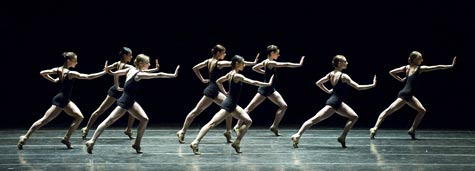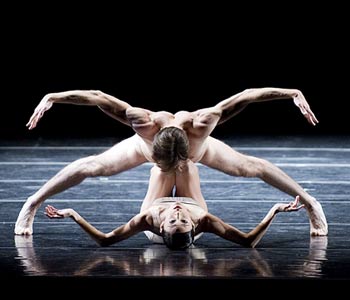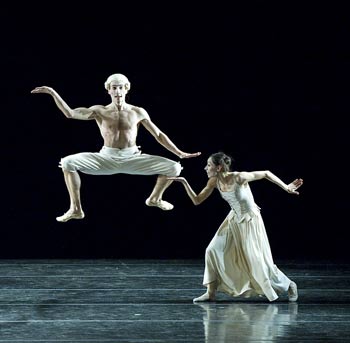
FALLING ANGELS: For women only, it's the Eleusinian Mysteries of dance.
|
Looking for a spooky Valentine? Try Jiří Kylián's Black and White. The Czech choreographer/Nederlands Dans Theater director made an evening out of five pieces — No More Play, Petite Mort, Sarabande, Falling Angels, and Sechs Tänze — he'd created between 1986 and 1991, and it's an unnerving battle of the sexes, now dark, now goofy. Last night Boston Ballet became the first company outside the Netherlands to perform the complete program.Kylián's unifying device is a set of formal, mostly black, dresses, just the bodice and the full skirt, hung on a framework with rollers. The dancers, men as well as women, pop up from behind them and pose; they push them on and off stage. During Sarabande the dresses rise and hover above the dancers. Kylián also makes use of foils in Petite Mort, and the operatic shenanigans of Sechs Tänze, which is set to Mozart's K.571 German Dances, are presented in period undergarments and wigs and chalky make-up. (There's nothing unified about Black and White's music, which ranges from Bach and Mozart to Anton Webern and Steve Reich.) The choreography is so spiky, and so sexually charged, you might wonder whether the props aren't a distraction.

PETITE MORT: The title may mean orgasm, but Rie Ichikawa
keeps Roman Rykine at a distance.
|
Set to Webern's savage, shadowy Five Movements for Strings, No More Play began with Sabi Varga standing behind Yury Yanowsky and holding his hands in front of Yanowsky's eyes and stomach, as if he were the Elegy Angel from Balanchine's Serenade; meanwhile, stage left, Lorna Feijóo, Nelson Madrigal, and Kathleen Breen Combes moved in lockstep like marionettes. This one's in edgy twos and threes. During the nocturnal second movement, Breen Combes stands on Varga's thighs and pulls him up, and later she stands on the back of his knee; in the last movement, Feijóo and Madrigal sit at the front of the stage with their legs dangling over the edge and cast huge shadows on the back wall. At the end, all five sit facing away from us and then lie back, heads hanging over the edge of the stage. It's a community — but unlike the communities of Twyla Tharp and Mark Morris, it's not one we're invited to join.
"Petite mort" is French slang for "orgasm." Any questions? Set to the slow movements from Mozart's Piano Concertos Nos. 23 and 21, Petite Mort opens with six men backing toward us, each balancing a foil on his right index finger. They swish the foils, roll them around on the floor with a toe, execute a kind of rifle drill. Eventually six women come forward behind their dresses and dance wistfully with them. We get, one by one, six duets; on more than one occasion, a man's descent into his partner is blocked by her knees and he floats on them. At the end, five of the six dresses are rolled toward center stage.
In Sarabande and Falling Angels, which Boston Ballet presented in March 2005, men and women part company. The six men of Sarabande, who're miked (the only other sound, toward the end, is part of Bach's Violin Partita No. 2), go primate/primal: breathing, doing pilates, crawling, creeping, swimming, flopping, deflating, bicycling, finger-pointing, whistling, clucking, slinging their undershirts about, pulling their trousers down, doing individual solos, finishing with a cacophony of screams. The eight women of Falling Angels (to the first part of Steve Reich's Drumming) sashay, dribble, wiggle, waggle their hands, tug at their shirts, run in place, do slow-motion martial arts, put their hands to their mouths or over their ears, and give birth before finishing in sexual ecstasy (or death throes). It's the Eleusinian Mysteries of dance.

SECHS TÄNZE: Roman Rykine and Erica Cornejo don't need props.
|
Where do men and women go after getting back in touch with being men and women? To a Mozart opera, Figaro or Cosí fan tutte (though Feijóo's pleading with Pavel Gurevich suggests rather Tosca). There's duos and trios and lots of switching off in the six teasing skirt swishers and tuggers of Sechs Tänze. When she's bumped out of a trio, Erica Cornejo sits and flashes the audience a wry smile before being retrieved. Boyko Dossev and James Whiteside exit opposite in a snit after discovering they're wearing the same dress; later Whiteside turns up with one of those foils and slices Dossev's head off. Feijóo gets manipulated and then ignored by Gurevich and Altankhuyag Dugaraa; Dugaraa then looks pleased with his fish-dive position in Gurevich's arms until he realizes he's in a girl's pose. When the music ends, soap bubbles flood the stage and the dancers try to catch them. Here especially, less might have been more. Kylián's choreography has already stripped the late 18th century down to its sexual politics; the rest is just window dressing.It's always hard to single out dancers in ensemble pieces. Breen Combes and Varga excelled in No More Play, and Dossev and Larissa Ponomarenko in their Petite Mort duet. Gyrating with his trousers around his ankles in Sarabande, Yanowsky achieved Blakean stature; Cornejo was kicky-kinky in her Falling Angels solo; Jared Redick confirmed his gift for comic Mozart. The energy was palpable everywhere; you could throw a rock and hit a good performance.